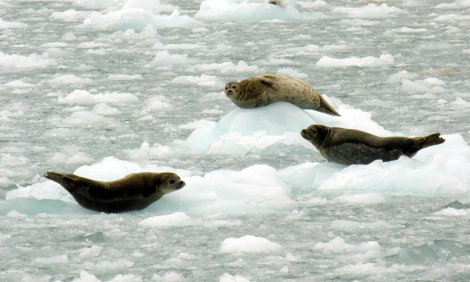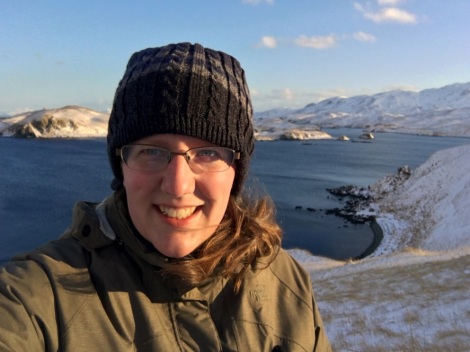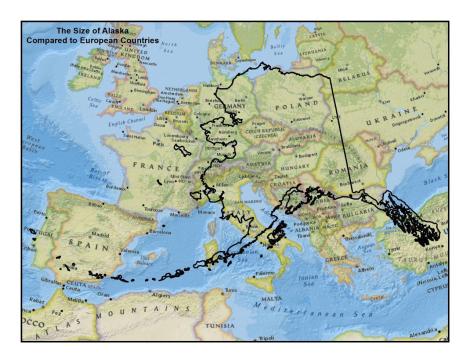Dr. Amy Bishop, PhD 2015
Since finishing my PhD as part of the Twiss behaviour lab, I have packed up my life and moved across the world.
Which is why you can now find me bundled up in September muttering ‘winter is coming’.
I hear American accents everyday, not just in passing.
I have had ‘moose and bear safety training’.
I’m in Alaska.
No, I can’t see Russia from my house.
Alaska is a unique place. It is 13x the size of England, but only has a population similar to the City of Leeds (~700,000). Because of the scale, the harsh winters, the rapidly changing climate, and the general ruggedness that is required to live up here, managers and scientists have to be creative and collaborative to monitor the environment.
Which leads me to my new job: I am currently a post-doctoral fellow with Dr. Jennifer Burns and Dr. Eric Bortz at the University of Alaska Anchorage; in partnership with the Alaska Native Harbor Seal Commission. The ANHSC is a non-profit, co-management group that represents Alaska Natives who rely on harbor seals for subsistence nutrition and for cultural traditions. After travelling to some of the remote villages, and seeing for myself that a single loaf of bread can cost upwards of $8 (£6!) it is clear why many of these villages rely on traditional hunting and natural resources.
Since 1996, partnerships between Alaska Native hunters and researchers have been developed to help monitor the health of harbor seal populations in Alaska. As the Biosample Project Manager, my role is to work with Native Hunters and train them on the protocols for collecting scientific measurements and tissue samples from harvested seals. I then facilitate the scientific research assessing the health of seals (stress hormones, disease screening, stable isotopes etc.), specifically seals in the Aleutian Islands. So far, I’ve travelled to the Aleutians Islands of Atka and Unalaska and have spent a lot of time remembering from my undergraduate days how to run a PCR analysis. This does mean that for the time being I’ve traded watching seals, identifying individuals, and pouring over videos of behaviours and instead find myself driving around seal carcasses (investing in car air-fresheners), dissecting bits of tissues, or pipetting carefully in fume hoods.

Harbor seals (Phoca vitulina) hauled out on ice. In certain parts of Alaska, seals take advantage of glacially calved ice to rest and give birth.
The skills I learned during my time with the Twiss lab have been excellent preparation for my current work: learning to keenly and quietly observe, managing fieldwork, organizing large databases, working with researchers and people with vastly different backgrounds, and investigating biology of seals—all of it has prepared me for this new adventure. But what I’m most happy about, is that my ‘learning’ hasn’t ended with the conference of my degree. Taking on a postdoc that was just an extension of my PhD didn’t really ever appeal to me. Being curious and excited about new directions in science is why I got into the ‘biz’ in the first place. I’ve lucked out in that I was able to find a position where I had plenty to learn, and amazing mentors to help guide me. In return, what I learn here will hopefully open more doors in the future, and help me continue to pursue interdisciplinary projects that incorporate these new molecular techniques with the behavioural ecology skills I developed during my time with the Twiss Lab!
One last quick note: During my PhD, not only was I learning new skills as a researcher, but at the time I was the only American in the Twiss behaviour lab, so a big part of my PhD was learning a new culture too. It might have taken the full four years, but I was eventually conditioned to spelling it ‘behaviour’ and not ‘behavior’. I no longer needed to do mental math whenever someone told me it was 12°C outside. I took my tea with milk, and I cheered during the Six Nations instead of the Super Bowl. I learned to drive on the left side of the road, and got ‘better’ at dealing with roundabouts. I complained about the weather. I queued like a pro. That is why I would encourage any students considering graduate studies to MOVE. Yes, staying at your undergraduate university might be ‘convenient’, but the life experiences you gain by hauling your life around the globe, meeting new people, and being exposed to new ways of thinking is just as much a transferable skill as database management. It’s life management!
If you have any questions or want to get in touch feel free to email me at: ambishop2@uaa.alaska.edu


